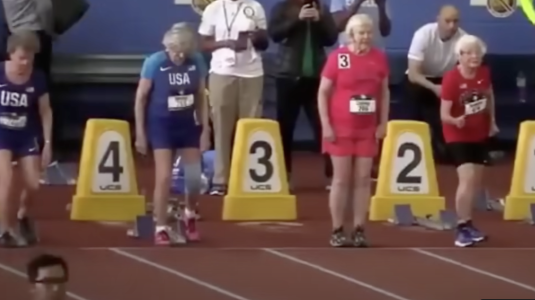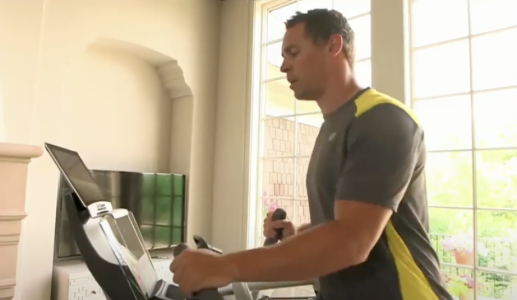Want to get fit at any age? Here are 4 science-backed tips from an expert who studies athletes as old as 92
- Replies 0
At The GrayVine, we know that age is just a number—and when it comes to fitness, the latest science is proving it!
If you’ve ever wondered whether it’s “too late” to get in shape, let us introduce you to some truly inspiring stories and practical advice from Lorcan Daly, a sports scientist who studies champion rowers well into their 90s.
Yes, you read that right—athletes as old as 92 are still breaking records and redefining what’s possible.
Meet the Champions: It’s Never Too Late to Start
Lorcan Daly, a lecturer in sports science at the Technological University of the Shannon in Ireland, has spent years researching how aging affects athletic performance.
His work focuses on older indoor rowers, some of whom didn’t even pick up the sport until their 70s or later.
One standout example is Daly’s own grandfather, Richard Morgan, who started rowing at 73 and went on to win four world championships by the age of 92.
Daly’s research—and the stories of these remarkable athletes—send a clear message: It’s never too late to start moving. Even if you’ve been sedentary for years, you can still make significant improvements in strength, endurance, and overall health.

The Science Is In: Small Steps, Big Benefits
You don’t have to train like an Olympian to see results. In fact, studies show that even modest increases in physical activity can have a dramatic impact on your health and longevity:
4 Tips for Getting Fit at Any Age
Ready to get started? Here are four expert-backed tips inspired by Daly’s research and the world’s most inspiring older athletes:
1. Mix Endurance and Strength Training
Daly’s “perfect recipe” for lifelong fitness includes both endurance (aerobic) and strength (resistance) exercises.
Why? Endurance activities like walking, swimming, or cycling keep your heart and lungs healthy, while strength training (using weights, resistance bands, or even your own body weight) helps maintain muscle mass, bone density, and balance.
How to start:

2. Make Movement a Non-Negotiable Part of Your Routine
Think of exercise like brushing your teeth—something you do automatically, not just when you “feel like it.”
Daly emphasizes that the key is to build activity into your daily schedule so it becomes a habit, not a chore.
Pro tip:
Don’t let the idea of “not being an athlete” hold you back. Even tiny increases in activity can yield huge benefits.
If you’re starting from scratch, try alternating days: walk one day, do sit-to-stands or gentle bodyweight exercises the next.
Remember, progress is progress, no matter how small. Celebrate every step forward!
Also read: Unlock the secrets of staying young: How people in their 70s and 80s are beating you at the gym!
4. Find Your Fitness Community
One of the best motivators? Doing it together! The rowers Daly studied were all part of a club, but you don’t need to join a team to reap the rewards.
Exercising with friends, family, or even a virtual group can make movement more enjoyable and keep you accountable.
Ideas to try:
- Invite a neighbor for a daily walk.
- Join a local fitness class for older adults.
- Try online exercise groups or challenges.
Source: Guardian Sport / Youtube.
Bonus Tip: Use Technology to Stay on Track
Today’s tech can help you gamify your routine and stay motivated. Fitness trackers, smartphone apps, and even simple pedometers can help you set goals, track progress, and celebrate milestones.
Some apps even let you “compete” with friends or earn rewards for consistency.
It’s easy to look at professional athletes and think, “That’s not me.” But as Daly and his research show, you don’t have to be a champion rower to reap the benefits of movement.
Every bit of activity—no matter how small—can improve your quality of life, boost your mood, and help you stay independent as you age.
Also read: Forget the gym! Discover the everyday activities that torch calories faster than exercise!

Have you recently started a new fitness routine? What’s your favorite way to stay active? Or maybe you have questions about getting started? Share your stories, tips, and questions in the comments below!
If you’ve ever wondered whether it’s “too late” to get in shape, let us introduce you to some truly inspiring stories and practical advice from Lorcan Daly, a sports scientist who studies champion rowers well into their 90s.
Yes, you read that right—athletes as old as 92 are still breaking records and redefining what’s possible.
Meet the Champions: It’s Never Too Late to Start
Lorcan Daly, a lecturer in sports science at the Technological University of the Shannon in Ireland, has spent years researching how aging affects athletic performance.
His work focuses on older indoor rowers, some of whom didn’t even pick up the sport until their 70s or later.
One standout example is Daly’s own grandfather, Richard Morgan, who started rowing at 73 and went on to win four world championships by the age of 92.
Daly’s research—and the stories of these remarkable athletes—send a clear message: It’s never too late to start moving. Even if you’ve been sedentary for years, you can still make significant improvements in strength, endurance, and overall health.

A sports scientist, Lorcan Daly, who studies older athletes, emphasises that it’s never too late to start exercising and achieving significant health benefits, even at an advanced age. Image source: CBS News / Youtube.
The Science Is In: Small Steps, Big Benefits
You don’t have to train like an Olympian to see results. In fact, studies show that even modest increases in physical activity can have a dramatic impact on your health and longevity:
- A 2022 study from the National Cancer Institute found that adults aged 66-76 who did 150-300 minutes of aerobic exercise per week, plus resistance training once or twice a week, had a 41% lower risk of dying from any cause compared to those who did neither.
- Another study published in the British Journal of Sports Medicine in 2023 found that just 10 minutes of moderate to vigorous activity per day (think brisk walking, cycling, or even energetic housework) reduced the risk of death by up to 55%—even among people who were otherwise sedentary for most of the day.
4 Tips for Getting Fit at Any Age
Ready to get started? Here are four expert-backed tips inspired by Daly’s research and the world’s most inspiring older athletes:
1. Mix Endurance and Strength Training
Daly’s “perfect recipe” for lifelong fitness includes both endurance (aerobic) and strength (resistance) exercises.
Why? Endurance activities like walking, swimming, or cycling keep your heart and lungs healthy, while strength training (using weights, resistance bands, or even your own body weight) helps maintain muscle mass, bone density, and balance.
How to start:
- Alternate between a brisk walk one day and simple strength moves the next (like sit-to-stands from a chair, wall push-ups, or light dumbbell exercises).
- Gradually increase the duration and intensity as you feel comfortable.

Combining endurance and strength training is ideal for overall fitness and healthy aging, with research showing this routine can lower the risk of death from any cause. Image source: The Wall Street Journal / Youtube.
2. Make Movement a Non-Negotiable Part of Your Routine
Think of exercise like brushing your teeth—something you do automatically, not just when you “feel like it.”
Daly emphasizes that the key is to build activity into your daily schedule so it becomes a habit, not a chore.
Pro tip:
- “Anchor” your new habit to an existing one. For example, do 10 minutes of stretching after your morning coffee, or take a walk after lunch.
- Use reminders, set alarms, or keep your walking shoes by the door.
Don’t let the idea of “not being an athlete” hold you back. Even tiny increases in activity can yield huge benefits.
If you’re starting from scratch, try alternating days: walk one day, do sit-to-stands or gentle bodyweight exercises the next.
Remember, progress is progress, no matter how small. Celebrate every step forward!
Also read: Unlock the secrets of staying young: How people in their 70s and 80s are beating you at the gym!
4. Find Your Fitness Community
One of the best motivators? Doing it together! The rowers Daly studied were all part of a club, but you don’t need to join a team to reap the rewards.
Exercising with friends, family, or even a virtual group can make movement more enjoyable and keep you accountable.
Ideas to try:
- Invite a neighbor for a daily walk.
- Join a local fitness class for older adults.
- Try online exercise groups or challenges.
Source: Guardian Sport / Youtube.
Bonus Tip: Use Technology to Stay on Track
Today’s tech can help you gamify your routine and stay motivated. Fitness trackers, smartphone apps, and even simple pedometers can help you set goals, track progress, and celebrate milestones.
Some apps even let you “compete” with friends or earn rewards for consistency.
It’s easy to look at professional athletes and think, “That’s not me.” But as Daly and his research show, you don’t have to be a champion rower to reap the benefits of movement.
Every bit of activity—no matter how small—can improve your quality of life, boost your mood, and help you stay independent as you age.
Also read: Forget the gym! Discover the everyday activities that torch calories faster than exercise!
Key Takeaways
- A sports scientist, Lorcan Daly, who studies older athletes, emphasizes that it’s never too late to start exercising and achieving significant health benefits, even at an advanced age.
- Combining endurance and strength training is ideal for overall fitness and healthy aging, with research showing this routine can lower the risk of death from any cause.
- Even short bouts of physical activity — as little as 10 minutes a day — can greatly reduce health risks and improve quality of life, especially for those who have been sedentary.
- Making exercise a regular habit by linking it to existing routines or working out with friends or family increases motivation and helps ensure long-term consistency.
Have you recently started a new fitness routine? What’s your favorite way to stay active? Or maybe you have questions about getting started? Share your stories, tips, and questions in the comments below!






